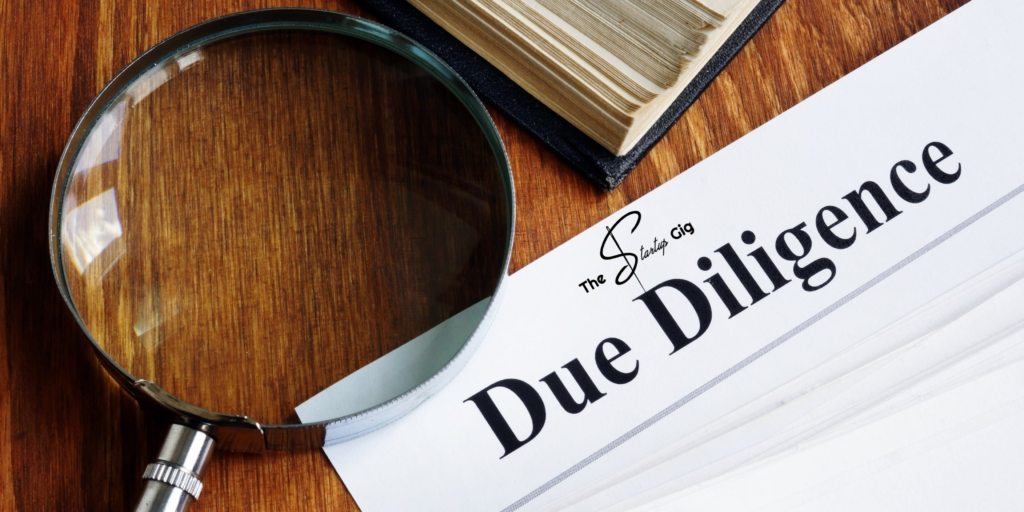In this blog, we will discuss the steps involved in the exercise of the due diligence process. Due diligence is basically the extraction of maximum information and relevant documents from the target startup or company on whom due diligence is conducted.

What is the due diligence process?
Preliminary research is conducted on the extracted information and documents. After initial or preliminary research, new discoveries or findings come to attention on which various doubts and queries are raised. Based on this a questionnaire list is prepared for the response of the target startup or company. After the response is received, one may find mention of more things in it on which one gets an idea about the real state of affairs of the startup or company. Based upon this, one can request more information and additional documents from the startup or company. This process goes on till the researcher is completely satisfied with the information and documents that are received and on which he will be able to provide the most accurate due diligence report to the investor or acquirer. So we will now see in detail the steps involved in the exercise of due diligence.
There are 6 steps involved in the due diligence process:
- Planning Phase
- Information access and its examination
- Checklist or questionnaire for due diligence
- Analaysis of Information
- Requesting additional information or requisition list
- Due Diligence report preparation
Planning Phase
This phase in the due diligence process involves the determination of the exact scope of the due diligence process and its specific focus areas. Firstly the investor or the acquirer has to choose the target startup or company he wants to invest in or wants to acquire or have a stake or ownership in it. After the finalization is done, he should opt for the services of a person who has expertise in conducting the due diligence process.
This can be a lawyer or more specifically a startup lawyer who has expertise in dealing with startups i.e. a startup lawyer. The expert would first do the planning of how he would conduct the due diligence process with respect to that particular startup or company and prepare a strategy for the same. He would also appoint an appropriate team for performing the due diligence. If the investment or acquiring transaction is complex, then a larger team would be required for performing such due diligence. After appointing, the team is provided with timelines or duration within which such due diligence has to be completed. A sufficient amount of time is provided in case of complex transactions.
Information access and its examination
It basically involves obtaining information about the target startup or company in whom investment will be made. Information about a listed startup or company, which is in the public domain, can be obtained through the documents namely offer document or red-herring prospectus filed with the appropriate authority. Such documents give information regarding the laws and regulations that such a startup or company is subject to, approvals, permissions, and licenses obtained by it for the legal compliances.
Information about an unlisted startup or company is not public and can be difficult to get. In such a case, the course of action is to first decide the field or industry in which it operates. After deciding, deep research can be conducted on such industry. Suppose if an investor wants to acquire or invest in an online travel or tourism startup then he should check the documents filed by MakeMyTrip or yatra, as the operating industry is similar in both cases. The laws and regulations governing both of them will also be mostly similar. It also involves how the information and documents would be received and stored which can be either physical or virtual. Such information and documents are extremely sensitive and highly confidential. Hence there should be restricted access to such information and documents by involving only a few key people to work on it. Storing such information digitally can be beneficial as it prevents unauthorized copying and it gives access to a select few key people. It saves a lot of time and expenses. Based on the information and documents received, preliminary or initial research is conducted.
Checklist or questionnaire for due diligence
After the preliminary research, the next step in due diligence process is preparing a list of questions or a checklist for the target startup or company. This list is forwarded to the officials of the target startup or company who would provide their response to the same as requested in the checklist or questionnaire.
Analysis of Information
After sending the questionnaire or checklist, the officials of the target startup or company provide their answers to the questionnaire or submit the documents as requested from them. The expert carrying due diligence classifies such information, studies it, analyzes it, and makes a note of all the relevant information received from the officials.
Requesting additional information or requisition list
Sometimes it might happen that information required as per the questionnaire or checklist is not provided or is incomplete or is missing or some documents as requested have not been provided or are missing. So a pending list or additional list of questionnaires or documents is prepared and is forwarded to the target startup or company and the information or documents so required are requested to be provided. After receiving the above-said information or documents, they are studied, analyzed and notes are made from them.
Due diligence report preparation
After the analyzing process is over, the preparation of the due diligence report begins. The report is a prepared chapter wise wherein each chapter highlights the state of affairs with respect to the specific aspect of the startup or company. Such a report should be prepared in a reader-friendly, crisp, and simplistic way.
It should have fewer pages with real information and the rest of the factual data should be sent as annexures. This report comprises various chapters which include an executive summary, corporate matters, financial matters, tax matters, consents and approvals, material contracts, litigations, human resources, insurance, intellectual property rights, annexures. The major and key findings, discoveries, risks(shown as red flags), and other realities from the study of information and documents received are showcased in the above chapters.
At the start of the due diligence report, an executive summary is provided which is a short summary of the major and key findings and the risks involved. It is used for quick reference enabling the reader to get the headlines without having to go through a massive document. There will be many inconsistencies during the finalization of the due diligence report. To tackle this, several measures should be provided in the due diligence report to resolve the deadlock and overcome the difficulties or obstacles in it and thus reduce the legal or financial risk of the investor or acquirer.
Conclusion
This blog will help the readers, entrepreneurs, startup investors to broadly understand the background work that goes on behind the due diligence process. A simplistic approach has been adopted to explain the steps involved in the due diligence process so that even a layman can understand it. Obviously, there are various technicalities involved in a due diligence transaction for which expert advice may be sought from a lawyer or a startup lawyer who has expertise in dealing with due diligence transactions relating to startups. In the next blog, we will see the major risks associated or red flags that are discovered after performing a due diligence process with respect to a startup or a company.
For any other Queries and services regarding startups and company law visit – The Startup Gig




